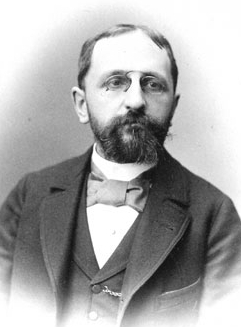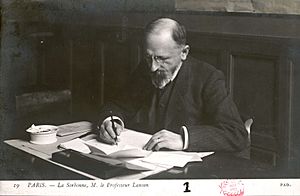Gustave Lanson facts for kids
Gustave Lanson (born August 5, 1857 – died December 15, 1934) was a French historian and literary critic. He taught at famous universities in Paris, like the Sorbonne and the École Normale Supérieure. Lanson was a very important person in French literary studies. He taught many students and influenced writers and critics for years. He believed in studying texts very carefully, using lots of research and historical facts.
Biography
Lanson helped change the French university system in the early 1900s. He was also a leading expert in literary criticism. He is best known for his ideas on literary history. He tried to combine the study of literature with the study of culture. He also greatly helped the study of pedagogy (the art of teaching). He thought it was important to use "explication de texte," which is like close reading today. This means looking at a text in great detail.
Lanson came up with the idea of "literary sociology." This was a complex way of looking at how society affects a writer. It also considered what readers expect and how a text is put together. For Lanson, a text was not just a product of society. It was also not just a work by a single genius. It was something in between. He believed society had strong, hidden influences on a text. But a text could also show something beyond those influences, like a hope for something better.
In 1911, Lanson was a visiting professor at Columbia University in New York City. During this time, he traveled a lot in the United States. He visited many college campuses. Later, he wrote about his experiences. Lanson was surprised by how important religion was on American campuses. But he also noted that the unity from shared religion was fading. Instead, shared interest in college sports, especially American football, was growing.
In 1919, he became the director of the École Normale Supérieure. For years, he was the target of funny attacks by Jean-Paul Sartre. He got very upset with a 1927 anti-war cartoon. Sartre and Georges Canguilhem published it in the university magazine. In the same year, Lanson had to resign. This happened after a media prank by Sartre and his friends. In 1927, Lanson's large library of about 11,000 books was sold. It went to Duke University in North Carolina for 125,000 francs.
Lanson's fame, especially in the United States, slowly went down after he died. It was at its lowest in the late 1950s and 1960s. During the time of the New Criticism, people focused on metaphors and images. They also separated texts from how they were created. Lanson was seen as someone too focused on historical details. However, in recent years, interest in Lanson has grown. This is because critics are now looking for ways to combine different methods of studying literature.
Works
Here are some of the books and writings by Gustave Lanson:
- Le Théâtre Classique au Temps d’Alexandre Hardy (1891).
- Bossuet (1891).
- Boileau (1892).
- Histoire de la Littérature Française (with Paul Tuffrau, 1894).
- Hommes et Livres: Études Morales et Littéraires (1896).
- Corneille (1898).
- Études Pratiques de Composition Française (1898).
- Les Grands Maîtres et les Grands Courants de la Littérature Française Moderne (1900).
- Choix de Lettres du XVIIe Siècle (1901).
- L'Université et la Société Moderne (1902).
- Les Origines du Drame Contemporain. Nivelle de La Chaussée et la Comédie Larmoyante (1903).
- L’Art de la Prose (1909).
- Choix de Lettres du XVIIIe Siècle (1909).
- Extraits des Philosophes du XVIIIe Siècle (1909).
- Manuel Bibliographique de la Littérature Française Moderne, 1500–1900 (1909–1912).
- Trois Mois d'Enseignement aux États-Unis (1912).
- Conseils sur l’Art d’Écrire (1913).
- Anthologie des Poètes Nouveaux (1913).
- Esquisse d’une Histoire de la Tragédie Française (1920).
- Manuel Illustré d'Histoire de la Littérature Française (2 vol., 1923).
- Voltaire: Lettres Philosophiques (2 vol., 1924).
- Méthodes de l’Histoire Littéraire (1925).
- Les Essais de Montaigne. Étude et Analyse (1929).
- Le Marquis de Vauvenargues (1930).
- Les Essais de Montaigne: Étude et Analyse (1930).
- Voltaire: Extraits (1930).
- Montesquieu (1932).
- Lettres Choisies des XVIIe et XVIIIe Siècles (1932).
Translated into English
- Problems of National Education (1900).
- "The New Poetry in France," The International Quarterly, Vol. 4 (1901).
- "Historic Method of Jules Michelet," The International Quarterly, Vol. 11 (1905).
- "France of Today," The North American Review, Vol. 195 (1912).
- "Address before the American Academy and Institute," The Art World, Vol. 1, No. 5 (1917).
- "The Modern Subjects in Secondary Education." In: French Educational Ideals of Today (1919).
- "Molière and Farce," The Tulane Drama Review, Vol. 8, No. 2 (1963).
- Moliere: A Collection of Critical Essays (ed. Jacques Guicharnaud, 1964).
- Voltaire (1966).
- "Literary History and Sociology," PMLA, Vol. 110, No. 2 (1995).
See also
 In Spanish: Gustave Lanson para niños
In Spanish: Gustave Lanson para niños



